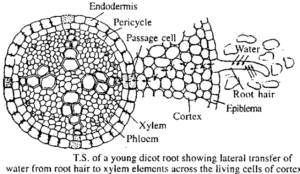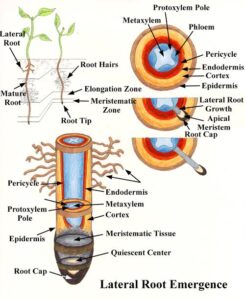Back to: Botany 200 Level
Hello, my brilliant student! I hope you’re doing great today! Have you ever wondered how plants absorb water from the soil and transport it all the way to their leaves? Unlike humans who drink water using their mouths, plants use their roots. But did you know there are two main ways plants absorb water—passive absorption and active absorption? Let’s break it down in a simple way!
Mechanisms of Water Absorption (Passive vs. Active Absorption)
Plants take in water mainly through their roots, but the method of absorption depends on different factors like the amount of water in the soil, the plant’s needs, and environmental conditions.
1. Passive Absorption – The Automatic Water Movement
What is it?
Passive absorption is the most common way plants take in water. It happens without the plant using any energy. Instead, water moves naturally from the soil into the roots due to differences in water potential.

How does it work?
The soil has a higher water potential than the root cells.
Water moves into the root hairs by osmosis (from high to low water potential).
Water then moves into the xylem and is pulled upwards by transpiration pull—the process of water evaporating from the leaves.
Example: Imagine a sponge placed in a bowl of water. The water moves into the sponge without you doing anything. That’s how passive absorption works!
When does passive absorption occur?
When transpiration is high (e.g., on a hot, sunny day).
When the soil has enough water.
Importance of Passive Absorption:
It allows plants to take in large amounts of water quickly.
It helps cool the plant through transpiration.
2. Active Absorption – When Energy is Needed
What is it?
Active absorption happens when the plant actively uses energy (ATP) to take in water. This occurs when there is low transpiration, like during the night or in humid conditions.

How does it work?
The plant’s root cells pump minerals into the xylem using active transport.
This lowers the water potential inside the roots.
Water moves against its natural gradient (from low to high water potential).
The force created is called root pressure, which helps push water upwards.
Example: Imagine using a straw to drink a smoothie. You apply force (sucking) to move the liquid upwards. Similarly, in active absorption, the plant actively pulls in water using root pressure.
When does active absorption occur?
When transpiration is low (e.g., at night or in humid conditions).
When water is scarce in the soil.
Importance of Active Absorption:
It ensures plants can still absorb water even when transpiration is low.
It helps plants survive in dry conditions.
Summary
Plants absorb water through two main mechanisms:
Passive absorption (the most common) occurs without energy, driven by transpiration pull and osmosis.
Active absorption requires energy and occurs when the plant actively pumps minerals into the root to create root pressure.
Evaluation
- What is the main difference between passive and active absorption?
- Which type of absorption happens mostly during the day?
- What role does transpiration play in water absorption?
- Why does active absorption require energy?
Great job! You are learning how plants manage their water supply so efficiently. Keep going—soon, you’ll understand how plants survive even in the toughest conditions. See you in the next lesson—Afrilearn is always here to make learning fun and easy for you!
